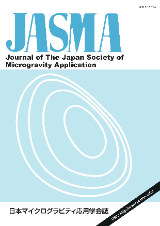Volume 19, Issue 3
The First International Announcement of Opportunity for Microgravity Science Research
Displaying 1-11 of 11 articles from this issue
- |<
- <
- 1
- >
- >|
-
2002Volume 19Issue 3 Pages 151-
Published: July 31, 2002
Released on J-STAGE: January 21, 2021
Download PDF (363K) -
2002Volume 19Issue 3 Pages 155-
Published: July 31, 2002
Released on J-STAGE: January 21, 2021
Download PDF (387K) -
2002Volume 19Issue 3 Pages 159-
Published: July 31, 2002
Released on J-STAGE: January 21, 2021
Download PDF (382K) -
2002Volume 19Issue 3 Pages 164-
Published: July 31, 2002
Released on J-STAGE: January 21, 2021
Download PDF (1667K) -
2002Volume 19Issue 3 Pages 167-
Published: July 31, 2002
Released on J-STAGE: January 21, 2021
Download PDF (380K) -
2002Volume 19Issue 3 Pages 171-
Published: July 31, 2002
Released on J-STAGE: January 21, 2021
Download PDF (580K) -
2002Volume 19Issue 3 Pages 177-
Published: July 31, 2002
Released on J-STAGE: January 21, 2021
Download PDF (232K) -
2002Volume 19Issue 3 Pages 179-
Published: July 31, 2002
Released on J-STAGE: January 21, 2021
Download PDF (1304K) -
2002Volume 19Issue 3 Pages 185-
Published: July 31, 2002
Released on J-STAGE: January 21, 2021
Download PDF (920K) -
2002Volume 19Issue 3 Pages 198-
Published: July 31, 2002
Released on J-STAGE: January 21, 2021
Download PDF (2220K) -
2002Volume 19Issue 3 Pages 203-
Published: July 31, 2002
Released on J-STAGE: January 21, 2021
Download PDF (290K)
- |<
- <
- 1
- >
- >|
